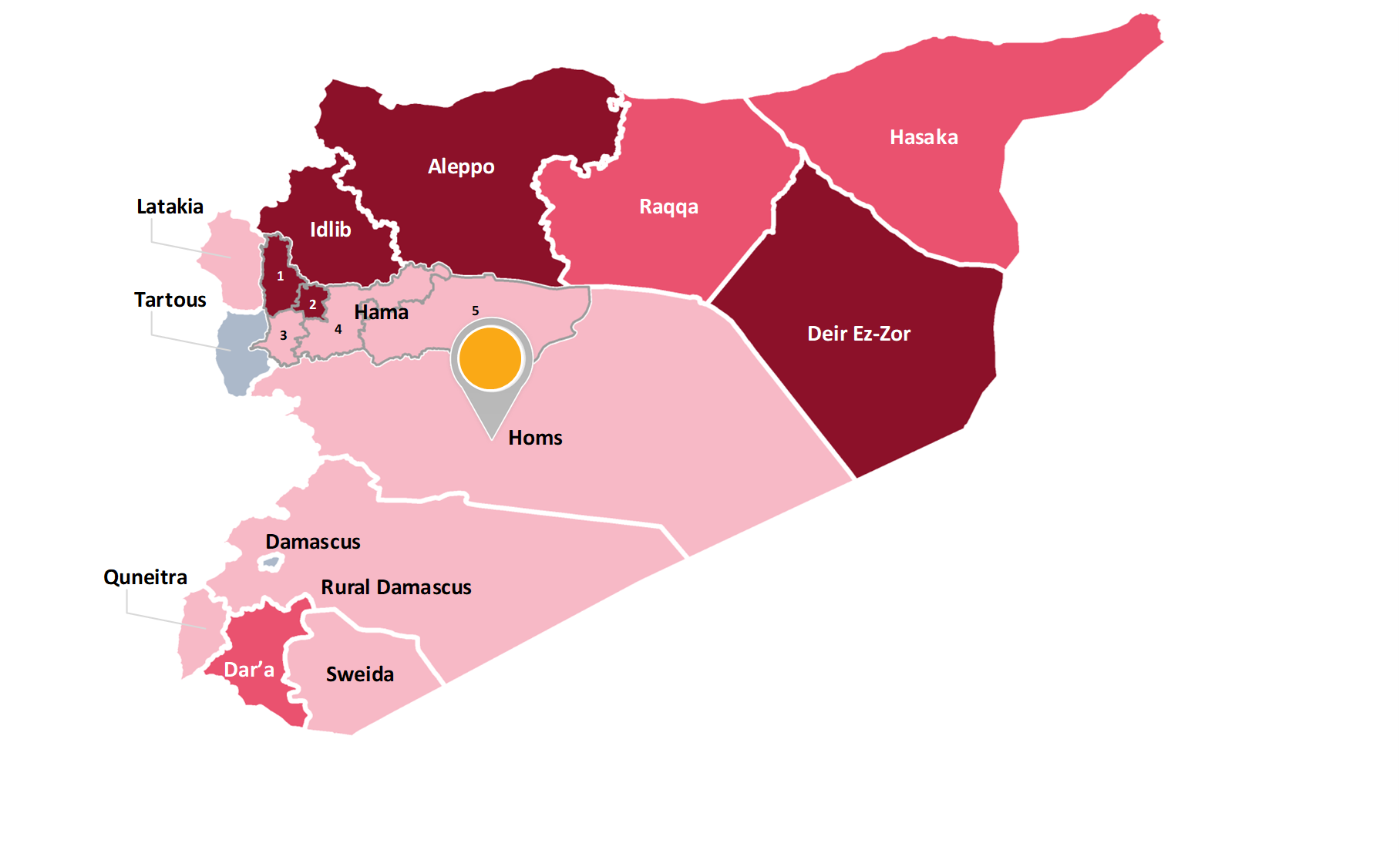[Main COI reference: Security 2020, 1.5.1, 2.6]
The governorate of Homs is located in central Syria and has borders with Iraq to the east and Lebanon to the west. The Syrian E-Government website stated that Homs governorate shares an international border with Jordan to the east as well. It has internal borders with Deir Ez-Zor, Raqqa, Hama, Tartous, and Rural Damascus governorates. The governorate is divided in six districts: Homs (where its capital Homs is also located), Al-Qusayr, Tal Kalakh, Ar-Rastan, Al-Maghrim and Palmyra. Homs governorate had 1 573 000 residents according to the official population estimates published by the Syrian Central Bureau of Statistics for 2016. Natural resources facilities are situated in the governorate.

As of March 2020, Homs governorate was under the control of the GoS forces, except for Al-Tanf region and some small ISIL pockets scattered in the Syrian Desert. The presence of SAA, GoS security apparatus, pro-government militias and anti-government armed groups was reported in the region. Iranian and Iranian-backed forces were deployed in proximity to strategically important posts. Russian Military Police also held a limited presence in northern rural Homs, with an insignificant role as of July 2019. The US had established a military base in Al-Tanf in 2016, which was used as a launching point for operations against ISIL and to train Syrian anti-jihadist opposition groups.
In 2019, numerous incidents involving ISIL and the SAA and pro-government forces have been reported, mainly in the eastern parts of the governorate. Such incidents included ambushes and IED attacks. From March through mid-October 2019, ISIL claimed to have conducted 32 insurgent attacks in Homs governorate [Security 2020, 1.4.6]. There were also reports of clashes between GoS forces and pro-government militias for economic interests and conflicting agendas. As these clashes reportedly escalated, machine guns and RPGs were used, causing injuries among civilians. Moreover, during 2019, Israeli airstrikes took place, allegedly resulting civilian casualties. Sources also reported several deaths among civilians caused by landmines and explosive remnants of war.
ACLED recorded 69 security incidents (average of 1 security incident per week) in Homs governorate in 2019, the large majority of which coded as battles and explosions/remote violence. In the first two months of 2020, the number of security incidents in the governorate was 10, amounting to an average of 1 security incident per week.
During 2019, security incidents occurred in all districts of the governorate, with the largest overall number being recorded in the districts of Tadmor and Homs.
In 2019, VDC recorded a total of 105 civilian fatalities and SNHR recorded a total of 70 civilian fatalities in the governorate. Compared to the official figures for the population in the governorate as from 2016, this represents respectively 7 or 4 civilian fatalities per 100 000 inhabitants.
Homs city suffered a high impact of displacement as approximately 468 000 out of 806 000 people were displaced by November 2013. In 2019, 13 000 IDP movements to or within the governorate were recorded. With regard to returnees, 44 000 return movements to or within the governorate were recorded. There are reports that mainly pro-GoS citizens were allowed to return, while IDPs who returned to Homs were requested by the government to pay for non-existent services, such as electricity and municipal fees, for all periods when these areas were out of its control, or when the returnees were out of the area.
Homs governorate is one of the most impacted amongst all governorates, both in terms of damage to infrastructure, and strains on areas receiving IDPs. Massive destruction of housing units, severe damages to road networks, insufficient quantities of potable water, disruptions to sewerage services and long power cuts were reported. Additionally, sources reported attacks that targeted natural resources facilities. In northern rural Homs, the state of lawlessness and the arbitrary use of State power have created a climate of fear. In June 2019, graffiti appeared calling for the people to continue the revolution against the government. There was also information on the seizing of weapons and munitions in the Homs countryside. The incidents of kidnapping, looting, and extortion had increased in Al-Rastan city, and civilians had cited increasingly frequent harassment, theft and tariff charges at checkpoints, used by pro-GoS forces for monitoring and conscripting civilians.
|
|
Looking at the indicators, it can be concluded that indiscriminate violence is taking place in the governorate of Homs, however not at a high level and, accordingly, a higher level of individual elements is required in order to show substantial grounds for believing that a civilian, returned to the territory, would face a real risk of serious harm within the meaning of Article 15(c) QD.
|
